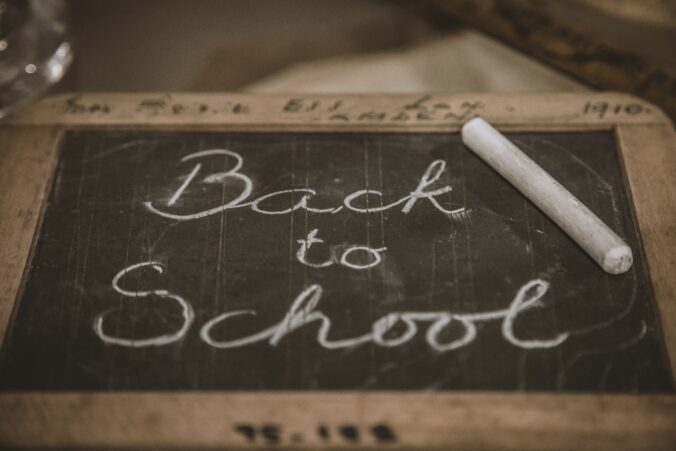Growing up in the 1930s, my father’s childhood was filled with all the trials and tribulations that came with belonging to a large family in rural Prince Edward Island during the Great Depression. It was a time of toil, sacrifice and hardship. Parents sent their children to school to receive an education, with hope that their children’s futures would have more opportunities and less struggle than their own.
For my father Joe, going to school meant heading to the little red schoolhouse up the road. Starting first grade wasn’t too intimidating….with so many brothers and sisters, there was always at least four or five of them attending school at any given time. The school had three classrooms: one for primary aged students, one for intermediate students and one for junior/senior high. The highest grade you could attain at the local schoolhouse was grade ten. To study at the grade eleven and twelve levels, students had to attend an upper level school such as St. Dunstan’s or Prince of Wales.
Each classroom had wooden desks for the students and the teacher, as well as a little pot bellied stove in the corner for heat. It was the responsibility of the teacher and older students to keep the fire burning and the wood stocked. There was no running water. When nature called, students had to head out to the dreaded outhouse, no matter what the weather. There was a pump in the basement for drinking water but no one had a cup. Joe and the other students had to make cups out of their hands when they wanted a cool drink.
The school taught all the classic subjects such as reading, writing, arithmetic, geography and history. My father always loved geography the best, learning about countries and places he could only dream about visiting someday. School supplies consisted of the bare necessities…..scribblers and pencils. He claims he never owned a schoolbag or a satchel. He doesn’t recall doing much studying or homework in the evenings, but does remember “borrowing a few answers” from his friends in school the next day.
Some children brought bag lunches to school, but most of the students who lived close enough went home for lunch. Before he left for school in the morning, my grandmother would ask Joe to bring her in a fish….salted cod that was stored in an outbuilding on their property. When he and his siblings came home at noon, she would have fish, potatoes and vegetables ready for their dinner. It was the big meal of the day. They had an hour for lunch, but the village kids often stretched it as long as they dared by stopping and lingering at the Dingwell and Rossiter General Store on the way back. Here, they would admire the penny candy and other treats for sale, and listen to a few of the local men swapping stories before rushing back to school.
The school day ran from 9:00 am -3:00 pm. Besides lunch hour, the students also had a couple of recess breaks. There was no playground equipment, so they played a lot of baseball and other schoolyard games, like hopscotch and tag. In winter, you could almost bank on a snowball fight to break out if the snow was just right. One time there was a scuffle in the schoolyard. Joe was the last one coming in after it disbanded and the principal took one look at him and said, “You must be the ringleader.” There are no corroborating witnesses, but she was probably not wrong.
In the 1930s, there were very few phones and not everyone had a radio. On a stormy winter day, there was no way of knowing if school was cancelled or not. Students had to make their way to the schoolhouse and hope that the teacher didn’t show up. One teacher who was bound to show up was Mabel O’Brien. A strict, no-nonsense woman, Mabel had an exemplary record of showing up to teach no matter the weather. On stormy days, the students held their breath and hoped she wouldn’t show so they could head home and enjoy a day off from learning. One student was posted as lookout and was constantly peppered with the question, “Is she coming?” Much to their disappointment, Mabel almost always materialized , walking down the road with her purposeful stride, ready to start the school day.
When all else failed, the students relied on a bit of mischief to get a day off. I have it on good authority that one of the village lads was tasked with occasionally plugging the chimney to smoke out the classroom and get school cancelled. I am happy to report that this mischievous young lad eventually mended his wayward ways and went on later to become a priest.
Perhaps my favourite story that my father remembers from his school years involved his friend, David. David could be a bit is a rascal in the classroom, much to the dismay of his teachers. This one particular year, the teacher also had the dubious distinction of being his older sister. One day, she reached the end of her rope with David’s shenanigans and suspended him for the rest of the day and sent him home. Their mother, who was not worried about offending the teacher in this particular instance, was having none of it, and sent him right back to school.
Even though my father’s school experience was vastly different from today’s students, there were some commonalities that transcend the years. For every generation of students past, present and future, school will always mean making friends, getting into some mischief, praying for an occasional day off and hopefully, a little bit of learning along the way.

Great story Kim love these glad you are back at it.